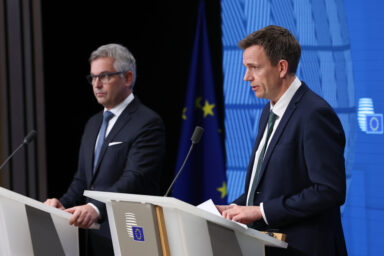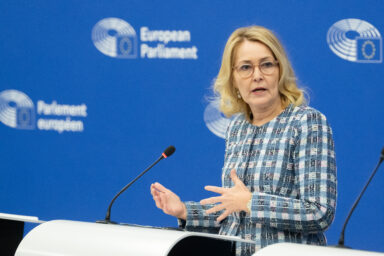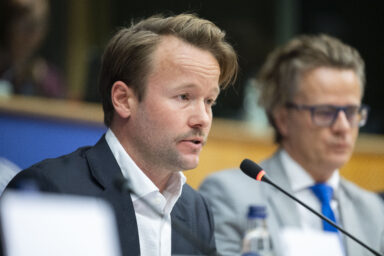As the European Parliament’s rapporteur for the forthcoming EU Cardiovascular Health Plan, MEP Romana Jerković (S&D/HRV) is clear that prevention must begin by confronting industries fuelling the disease. Above all, she wants to attack tobacco, alcohol, ultra-processed foods, and marketing practices that target children and vulnerable groups.
“Prevention cannot succeed if commercial interests keep shaping our environment against public health,” Ms Jerković says. Her statement builds on alarming trends of younger generations. Just last week at the Global Health Summit in Berlin, Health Commissioner Oliver Várhelyi stated that overweight, obesity and diabetes have increased over the last 30 years. “Today, almost 30 per cent of children (under age of 15) are overweight. With age these tendencies increase,” he claimed.
With the EU Cardiovascular Health Plan expected by the end of the year, Ms Jerković outlines in her interview with EU Perspectives how Europe can move beyond aspiration. She aims for a strategy that prevents disease, tackles the commercial forces undermining public health, and guarantees equal access to care. She also discusses the political will and EU–national cooperation needed to turn ambition into measurable impact.
What will be your top priorities in shaping this initiative?
My priorities are simple: prevent as much as we can, detect as early as we can and make effective treatments accessible everywhere. Cardiovascular disease remains Europe’s biggest killer, while so much of it is preventable. That’s why the first pillar of any serious European Cardiovascular Health Plan must be prevention and stronger action on tobacco, alcohol, air pollution, and unhealthy food. We also need routine, systematic checks in primary care for blood pressure, cholesterol, diabetes and heart rhythm disorders. These simple, low-cost interventions can catch risk factors long before they lead to heart attacks or strokes.
You might be interested
And finally, access. It’s unacceptable that where a person lives or how much they earn still determines whether they receive timely treatment, cardiac rehabilitation or modern lipid-lowering therapies. We must close both the regional and social inequality gaps in access to care. Every citizen deserves the same chance at keeping their heart healthy.
Where do you see the biggest gaps between current EU health frameworks and what cardiovascular patients actually need?
We have enormous gaps between what we see in the strategies and what actually happens on the ground. Ambitious goals are part of policy papers, but too often they never reach the patient. Patients should have a clear and coordinated care pathway for follow-up. Rehabilitation should be a guaranteed part of recovery, which is currently not the case. Too many patients leave hospitals having to navigate complex systems on their own, without access to structured cardiac rehab or secondary prevention. That’s where lives end and inequalities widen, and it’s exactly where the EU Cardiovascular Health Plan needs to drive change.
Health systems are run nationally. What is the one thing the EU can do on cardiovascular health that member states cannot achieve alone?
Health systems are indeed subject to national management. But the EU has two powerful tools that member states don’t necessarily have on their own, financial resources and collective knowledge. The EU can mobilise targeted funding to support screening initiatives, prevention campaigns and digital innovation. Many member states know what they need to do, but they lack the resources or capacity to do it at. Equally important is the EU’s role in sharing expertise and evidence by connecting national research, clinical networks and data to identify what truly works.
To make the Cardiovascular Health Plan truly transformative we have to deliver measurable change for patients. – MEP Romana Jerković
What specific elements do you intend to fight for to ensure plan is not just symbolic but transformative?
To make the Cardiovascular Health Plan truly transformative we have to deliver measurable change for patients. First, I will confront the commercial determinants of health head-on. That means stronger EU action on the industries that drive cardiovascular risk like tobacco, alcohol, ultra-processed food and marketing practices that target children and vulnerable groups. Prevention cannot succeed if commercial interests keep shaping our environment against public health.
Second, I will insist that gender and equity are at the heart of the plan. Women’s cardiovascular disease remains systematically underdiagnosed, under-researched and under-treated. Third, we must embrace innovation and data to modernise care. Artificial intelligence, if used responsibly, can help detect heart disease earlier, personalise treatment, and make health systems more efficient. But we need EU-level standards for safety, transparency, and interoperability.
From your perspective, what milestones should our readers look out for in the coming months as this initiative moves forward?
The crucial documents that are coming in the next few months are European Commission’s proposal for the Cardiovascular Health Plan and the European Parliament’s report. The Plan will show how ambitious the EU really intends to be. And whether prevention, early detection and rehabilitation are treated as true priorities. We at the European Parliament will fight to strengthen the Commission’s plan with clearer targets and dedicated funding.











